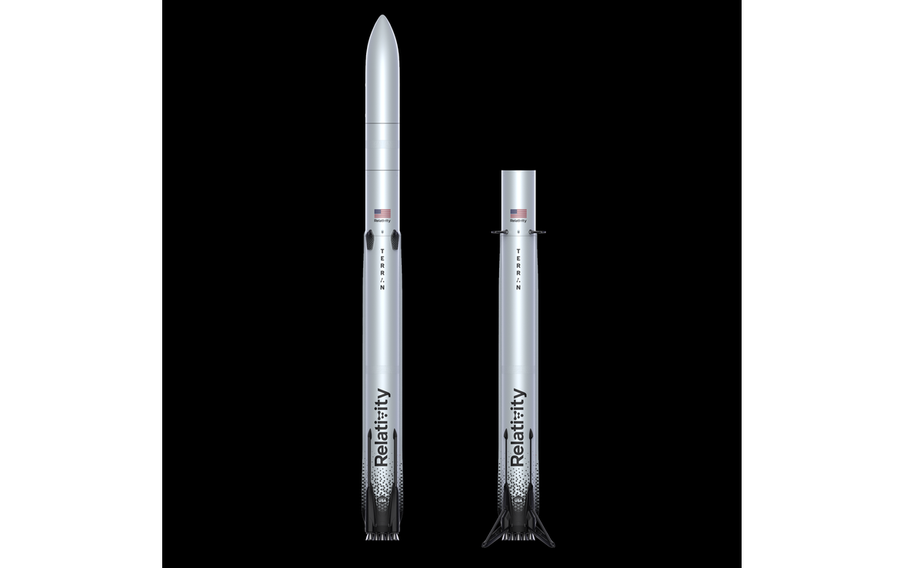
A fully stacked Terran R rocket beside its reusable first stage (Relativity Space)
Relativity Space plans to abandon future flights of its Terran 1 rocket less than a month after it first tested the 3D-printed vehicle. The company will instead shift operations toward a previously planned larger rocket in hopes of filling a growing market need and better competing with industry leader SpaceX.
This announcement Wednesday is a shakeup for the mostly unflown space startup, which conducted its sole flight on March 22 that reached space but failed to reach orbit. The pivot to this larger rocket, the Terran R, will likely mean Relativity won’t conduct additional launches until 2026, when it expects the vehicle to be ready for flight.
Chief Executive Officer Tim Ellis said the move was the “obvious choice” for the company as larger cargo loads are in higher demand.
“There really just are not good solutions in the market,” Ellis said in an interview.
Ellis said the company is now focusing almost exclusively on getting Terran R, which it announced in 2021, off the ground, with no concrete plans to launch Terran 1 again. The majority of Relativity’s customers are happy with the change in direction, Ellis said, adding that practically everyone who had signed up for space on the smaller rocket agreed to be moved over to Terran R.
Over the past decade, companies like Relativity have worked to capitalize on the so-called small-satellite revolution. Some, like Richard Branson-founded Virgin Orbit Holdings Inc., have run out of cash and filed for bankruptcy, as industry leaders have argued that the market might not support more than a couple of companies dedicated to launching small satellites.
“[The] small launch market, as I’ve said for however many years, has room for one or two [companies],” Tory Bruno, the CEO of United Launch Alliance, said during a panel with other launch providers at a satellite industry conference in Washington on March 15. “So Rocket Lab, perhaps, and one other, at most.”
“We saw it climb up a bit in 2020 and then collapse,” he added.
In recent years, the demand has shifted toward medium- to heavy-lift launchers as customers focus on building out massive satellite mega-constellations similar to SpaceX’s Starlink, which aims to beam broadband internet to Earth.
“There’s a huge under-supply,” said Chad Anderson, managing partner at the space-focused venture firm Space Capita, referring to the lack of larger transport rockets. “There’s growing demand and a bottleneck in supply, which means that people are having a hard time getting to orbit.”
The Elon Musk-led SpaceX, officially Space Exploration Technologies Corp., is far and away the leader in that space. While other medium to large vehicles are in development, only SpaceX’s Falcon 9 is currently flying and readily available. Moreover, Russia’s invasion of Ukraine last year led to Russia’s Soyuz rocket being unavailable for launch in much of the world.
“There is a definite need for diversified launch that is not just one company that’s also building their own satellite constellation,” Ellis said. “And so we just keep hearing from customers that this is a really, really big need.”
Terran R can carry between 23,500 kilograms and 33,500 kilograms (51,809 pounds to 73,855 pounds) to low Earth orbit, Ellis said. This is roughly on par with the capability of SpaceX’s Falcon 9 rocket.
Relativity, which Ellis co-founded in 2016, made a name for itself with the ambitious goal of manufacturing rockets almost entirely with 3D printing, which the company says can help it iterate on design more easily and cut down on costs and labor. By June 2021, the company had raised at least $1.3 billion and was valued at $4.2 billion without a single flight.
It launched its first test flight of Terran 1 on March 22 from the Cape Canaveral Space Force Station in Florida. The vehicle took off successfully and passed through Max-Q, the point during the flight where the craft experiences the maximum amount of stress and forces.
A little less than three minutes into the flight, after the lower stage of the rocket had separated and fallen away, the upper stage engine tried to ignite but cut off early. Terran 1 didn’t achieve orbit, though it did reach an altitude of 134 kilometers, or 83 miles, making it to space. The rocket eventually fell back to Earth and sank in the ocean. Ellis says that it appears an engine valve opened more slowly than it was supposed to, causing a chain reaction that shut the engine off early.
The Terran 1 was 85% 3D-printed, the company said, and used engines that run on methane, a new fuel the industry has started to adopt as it’s considered more conducive to reusability. The company plans to eventually make Terran R completely reusable, as well as make its vehicles 95% 3D-printed.
In addition to moving its Terran 1 customers to Terran R, Relativity said it’s still working with NASA to see if it can move a contracted launch through the space agency’s Venture Class Launch Services program to the new rocket. Ellis said the company had sold “several $100 million” customer contracts for Terran 1.
It’s also signed as much as $1.65 billion in contracts for Terran R, Ellis said. While Relativity isn’t releasing the price of an individual Terran R launch yet, the contracts represent seven customers and more than two dozen missions, the company said.
Relativity had initially said Terran R would be ready by 2024, but the new target date means it may be years before the rocket flies. Ellis said customers don’t mind the wait. “A lot of them are effectively telling us that they actually don’t believe anybody else is going to get there, to a relevant and disruptive capability, sooner,” he said.